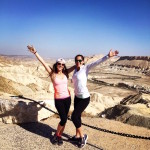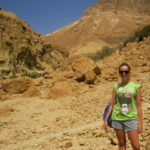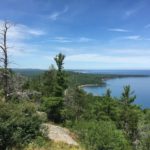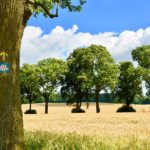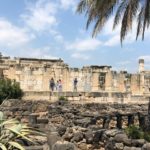How I Conquered Israel’s Desert Fortress, Masada
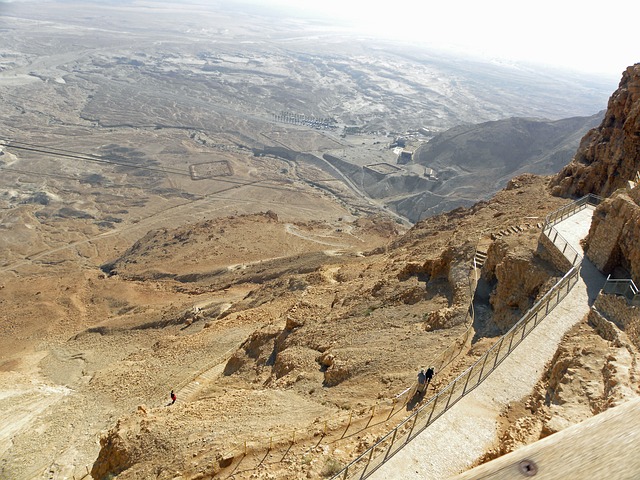
I wiped the dripping sweat off of my brow, panting under the blistering morning sun. Pausing to take a swig of cool, refreshing water, I gazed up to the top of the mountain and was suddenly troubled by how tiny the hikers approaching the summit appeared.
You can’t stop now, I thought wearily. Remember what you promised yourself?
This day, out of all of our nine days together, was the one that I had dreaded the most on our recent trip to Israel. The second we received our trip itinerary from Honeymoon Israel back in March, I had studied it with the intensity of an American high schooler preparing for the SAT college entrance exams. Scrutinizing the document, I nodded approvingly as I noticed the expected “usual suspects.” A visit to the Western Wall in Jerusalem? Check. Floating in the Dead Sea? Check. And then I saw it:
Monday, May 30, 2016
Climb Masada via the Snake Path to visit Herod’s mountain palace and site of the Jewish Zealots’ last stand against the Roman legionnaires.
So why were we visiting Masada in the first place, and what exactly is it?
Masada, it turns out, is a nearly 2,000 year old desert fortress overlooking the Dead Sea that was built by King Herod the Great. In addition to building up lavish palaces, a bath house, and a swimming pool on top of the mountain, Herod had a pretty nifty system of cisterns and aqueducts. In fact, the cisterns were reputedly so large that they could hold enough water to supply a thousand people with enough water for 10 years. Suffice it to say, this guy was well hydrated in the hot, arid desert.
But Masada is more than just one of King Herod’s architectural achievements: it’s a symbol of resolve for the Israeli people and an important place of pilgrimage.
Around 72 AD, Masada served as the last refuge for Jews that were rebelling against the Roman Empire. The Romans built no less than eight siege camps around Masada—the remains of which can be seen from the summit even today—along with a siege ramp up the side of the mountain. When the Roman attack on the fortress was imminent, the rebel leaders discussed their dire situation and, rather than be enslaved by the Roman Empire, chose instead to kill themselves. The men drew lots and ten were selected to kill the others. Eventually, one of the ten was chosen to kill the other nine and then commit suicide. They burned their belongings but left their food behind so that the Romans would know that they had not perished of hunger, but rather of their own free will.
Ten-year-old me would dart up hills and race back down to my parents, urging them along on our hikes through Monterey and Big Sur in California; thirty-year-old me huffed and puffed, muttering angrily and kicking pebbles and sticks out of my way.
There are three ways to ascend Masada. The first is by cable car (pictured below), which was built in 1971 and takes visitors from the base of Masada to the top. The second is the Roman Ramp, which is accessed from the western side of the mountain. And the third way–the way we were supposed to take–was called the Snake Path, which was much steeper than the Roman Ramp and leaves from the eastern side of the mountain.
I must have Googled the phrase “Snake Path Masada difficulty” about fifty times before our arrival in Jerusalem. Travel bloggers provided delightful descriptions of their experiences on the trail, like “my legs were trembling like jelly” and “As I climbed, the dizziness and nausea got worse and worse. I felt as if I were in the midst of my own personal siege on Masada.”
Great. Just great.
In the days leading up to the adventure, I lulled myself into a false sense of security about my ability to complete the trek. We walk all the time in New York City! Surely it can’t be that bad. I routinely walk from Times Square down to the Flatiron district–I must be golden!
But the night before our climb up Masada, a strong sense of doubt snaked its way into my head. “I’ll just take the cable car up,” I sighed to my husband as we turned off the lights. “It’s not like I’m in the best shape, anyway.”
That, my friends, was a severe understatement.
Nearly a year ago, I found myself flat on my butt yet again during a hike leading up to Queen’s Bath, a natural tide pool in Kauai. Certainly it hadn’t helped that my good friend and I had shared a mai tai before said hike, leading my already questionable sense of balance into the gutter.
But as I watched her maneuvering through the slippery, muddy lava rocks ahead of me with ease, I couldn’t help feeling a sense of hatred for the activity I had once loved as a child. Ten-year-old me would dart up hills and race back down to my parents, urging them along on our hikes through Monterey and Big Sur in California; thirty-year-old me huffed and puffed, muttering angrily and kicking pebbles and sticks out of my way.
How had I come to this?
And so ten minutes before our bus pulled up to the Masada Visitor Center, I decided that yes, I will hike up the Snake Path, thank you very much. For it wasn’t just about the fear of missing out on an experience that nearly everyone else in our group planned to do. It was very much about redemption, about proving to myself–and by extension, somehow, to my friend, though she wouldn’t know it at the time–that I could actually climb up these steep trails successfully and regain my love for hiking in the process.
Yes, Masada is an important symbol of Jewish freedom, of their determination to be free in their own land. But to me, conquering Masada meant finally starting to reconnect with a part of myself that I had missed, the part that loved to hike and run wild.
Things started out easy enough. Armed with plenty of water and making small talk with fellow group members, I strode confidently ahead on the gravelly terrain. I told our group’s rabbi that I wasn’t in shape, but was still hoping to get to the top unscathed.
“You’ll be totally fine,” she assured me before zipping off to the front of the pack.
We climbed up our first few switchbacks simultaneously with hordes of teenagers climbing down the mountain, regaling each other with tales of how sexy Joshua’s hair is and how I can’t wait to get freaky with Megan tonight. (Listen, I took frequent breaks, so I heard one too many of these stupid 17-year-old anecdotes. At least I’ll have some good ideas for a future young adult novel.)
Fortunately, the teens were too engrossed in each other’s lives to mind a heaving, red-faced thirty-year-old perched on a large slab of reddish stone.
As we ascended, though, we gradually began to fall further behind our group. I paused for the umpteenth time to catch my breath, and then it hit me: my husband wasn’t wheezing the way I was.
“Hey, how are you not out of breath?” I called up to him dejectedly.
“All that running up and down stairs all day at my law office!” he yelled back.
Ugh. Figures.
We plodded on, joined by another couple and our Israeli security guard, Shlomi. A little more than halfway through the trek, I made the mistake of asking him how long it would take him to hike up the mountain if it wasn’t for us.
“Twenty minutes,” he responded without hesitation.
It had now been forty.
The more we climbed, the more out of reach the summit looked. I stopped and thought long and hard about turning around. My water supply was nearly out, yet I was drenched with sweat.
King Herod, maybe you could build an aqueduct down to my FACE right now, because I am in need of some more water. Stat.
But then we heard the melodic voice of our tour guide, Uri, calling down encouragement to us about how close we were to the top. And then I looked behind me at Shlomi, whose saintly patience manifested itself through the small smile on his face. My husband retraced his steps and held out his hand to me. “Just one more push,” he said softly. “You got this.”
And then, finally, I wasn’t looking up any more; I was looking out. Across the gorgeous, striking ruins of palaces and barracks atop a 1400-foot mountain. I had conquered the pain-in-the-ass, make-me-want-to-vomit Snake Path up Masada–and I had loved it. The phenomenal views were worth it alone, but the feeling of emerging triumphantly at the summit was a thrill I had long ago forgotten.
As I staggered in to the shaded platform where our group was huddled atop the mountain, I was greeted by applause and hugs from my fellow groupmates. People I had known for less than a week were suddenly my biggest cheerleaders.
Yes, Masada is an important symbol of Jewish freedom, of their determination to be free in their own land. But to me, conquering Masada meant finally starting to reconnect with a part of myself that I had missed, the part that loved to hike and run wild. For this, I will be forever grateful.
(This post originally appeared on the author’s blog, It’s Five O’Clock Here).

